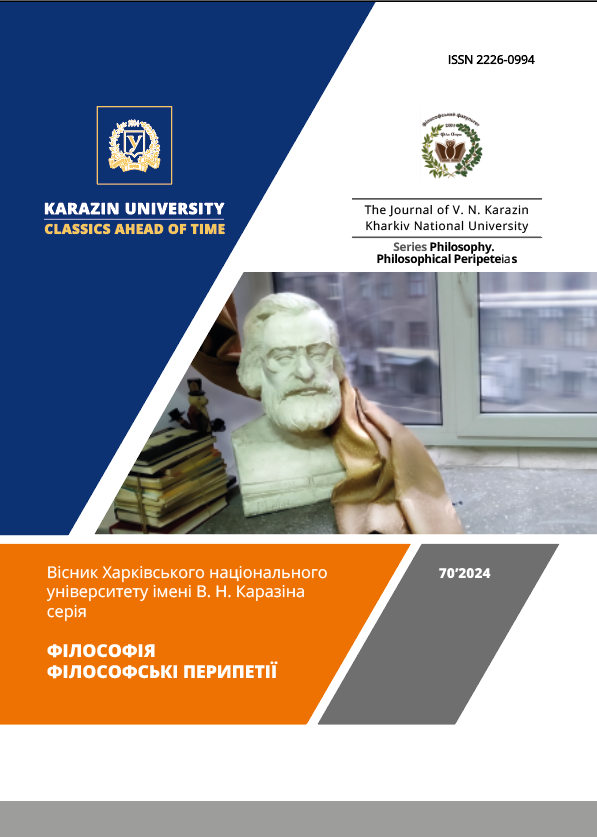THE SEDATIVE FUNCTION OF MATERIAL CULTURE: ON THE ESSENCE OF APOTROPAIC
Abstract
The methodology used by historians of emotions in their research is a subject of controversy. Understanding of the functional relationship between material culture and human emotions will allow solving them and systematizing approaches. The purpose of the article is to conceptualize the sedative function of material culture and reveal the potential of this concept for the history of emotions. The research was conducted within the structuralist approach using phenomenological and structural-functional methods. The psychoanalytical approach also played a big role in the research. The article examines the current state of the use of artifacts of material culture in the research of historians of emotions and the philosophical and ontological basis of considering material objects as full-fledged actors of emotional communities. Cultural theories were analyzed (TMT, mood management theory, P. Ado's concept of "spiritual practices" and others), their connection with the idea of the sedative function of material culture and the ontology of things in general. It was determined that the most demonstrative example of the implementation of the sedative function of material objects is apotropaic. Their use is considered through the prism of the concepts of "transitional object" (D. Winnicott) and "self-soothing practices" (Zh. Shvek). It has been established that the study of apotropaic as tools of individual and social management of affects will allow historians of emotions to learn more about the peculiarities of experiencing emotions in different communities, about the sources of these affects, the locations associated with them and the unconscious and conscious fantasies hidden behind them. The main function of apotropaic magic is the fight against negative emotions (horror, anxiety, hatred, envy, disgust) and their awakening for the purpose of neurotic retraumatization. This function can be considered not only in the case of apotropaic, but also for the analysis of other artifacts of material culture, including works of art and architecture. The study brings to the history of emotions a methodological rationale for the study of monuments of material culture, and to the philosophy of culture – the concept of a sedative function.
Downloads
References
Bion, W. R. (1995). Attention and Interpretation. Lanham: Rowman & Littlefield Published. https://books.google.com.ua/books/about/Attention_and_Interpretation.html?id=Ecs9tpsP2-0C&redir_esc=y.
Freud, S. (1977). Introductory Lectures On Psychoanalysis. NY: WW Norton & Company. https://mindsplain.com/wp-content/uploads/2020/08/introductory-lectures-on-psychoanalysis.pdf.
Foucault, M. (2006). Psychiatric Power: Lectures at The College de France, 1973-74. NY, Hampshire: Palgrave Macmillan. http://rebels-library.org/files/psych_power.pdf.
Greenberg, J., Solomon, S., Pyszczynski, T. (1997). Terror Management Theory of Self-Esteem and Cultural Worldviews: Empirical Assessments and Conceptual Refinements. Advances in Experimental Social Psychology, Vol. 29, pp. 61-139. https://www.sciencedirect.com/ science/article/abs/pii/S0065260108600167.
Hadot, P. (1995). Philosophy as a Way of Life. Oxford: Blackwell. https://ascetology.wordpress. com/wp-content/uploads/2016/09/pierre-hadot-philosophy-as-a-way-of-life-spiritual-exercises-from-socrates-to-foucault-1.pdf.
Heidegger, M. (1992). Parmenides. Bloomington: Indiana University Press. https://archive.org/details/martinheideggerparmenides/page/n177/mode/2up?q=hand.
Hinshelwood, R. D. (2020). Anxiety: Melanie Klein's 'deeper' layers. Metalepsis, vol. 1, pp. 25-41. https://www.semanticscholar.org/paper/Anxiety%3A-Melanie-Klein's-'deeper'-layers-Hinshelwood/62d2fca3bb4388b0e6be568eb04d602d5f321250.
Khodakivskyi O. (2022). Deceptive obviousness: modern approaches to the study of the history of emotions. NaUKMA Research Papers. History, 5 (December): 70-79. https://doi.org/10.18523/2617-3417.2022.5.70-79.
Klein, M. (1975). Envy and Gratitude, and other works 1946-1963. NY: The Free Press. https://www.sas.upenn.edu/~cavitch/pdf-library/Klein_Envy_and_Gratitude.pdf.
Lazarou, A., Liritzis, I. (2022). Gorgoneion and Gorgon-Medusa: a critical research review. Journal of Ancient History and Archaeology, vol. 9(1), pp. 47-62. https://www.jaha.org.ro/ index.php/JAHA/article/view/741.
Lorenz, M. (2012). Tiefe Wunden: Gewalterfahrung in den Kriegen der Frühen Neuzeit. IN: U. Bielefeld (ed.), Gesellschaft – Gewalt – Vertrauen (pp. 332-355). Leck: Clausen & Bosse. https://www.ruhr-uni-bochum.de/fnzgg/mam/content/lorenz__tiefe_wunden_jpr-festschrift.pdf.
Lunn-Rockliffe, S., Derbyshire, S., Hicks, D. (2019). Material culture, analysis of. IN: P. Atkinson (eds.), SAGE Research Methods Foundations. Newbury Park: SAGE Publications Ltd. https://doi.org/10.4135/9781526421036843497.
Morozova A. (2020). Explore emotions and feelings in a medieval city. City: history, culture, society. E-journal of urban studies, 10, 137-141. http://resource.history.org.ua/ publ/misto_2020_10_15. (In Ukrainian).
Norman, A. (2024). Transitional Objects in Early Childhood: The Value of Transitional Objects in the Early Years. NY: Routledge. https://books.google.com.ua/books?hl=uk&lr =&id=X_zwEAAAQBAJ&oi=fnd&pg=PA1999&dq=winnicott+transitional+object&ots=bjThyYgh5H&sig=FtUEErvkPHLFlWe4dWhEAzP4OhA&redir_esc=y#v=onepage&q=winnicott%20transitional%20object&f=false.
Pernau, M. (2021). Studying emotions in South Asia, South Asian History and Culture, 12:2-3, pp. 111-128, https://doi.org/10.1080/19472498.2021.1878788.
Reinecke, L. (2017). Mood management. IN: P. Rössler (Ed.), The International Encyclopedia of Media Effects (pp. 1271-1284). Hoboken: Wiley-Blackwell. https://onlinelibrary.wiley.com/doi/ pdf/10.1002/9781118783764.wbieme0085.
Rosenwein, B. H. (2010). Problems and Methods in the History of Emotions. Passions in Context, vol. 1, pp. 1–31. https://alioshabielenberg.com/wp-content/uploads/2020/06/ Rosenwein-2010-Problems-and-Methods-in-the-History-of-Emotions.pdf.
Stern, H. R. (1978). The Couch, Its Use and Meaning in Psychotherapy. NY, London: Human Sciences Press. https://archive.org/details/isbn_0877053030/page/n5/mode/2up.
Szwec, G. (2014). Les galériens volontaires. Paris: PUF.. https://www.amazon.com/galériens-volontaires-Essais-procédés-autocalmants/dp/2130628494?ref_=ast_author_dp.
Szwec, G. (2004). Les procédés autocalmants en psychosomatique et en psychiatrie de l'enfant: Self-soothing procedures in psychosomatics and child psychiatry. Neuropsychiatrie de l'Enfance et de l'Adolescence, vol. 52(6), pp. 410-413. https://www.sciencedirect.com /science/article/abs/pii/S0222961704001163.
Trigg, S., Welch, A. (2023). Objects, Material Culture and the History of Emotions in Medieval and Early Modern Europe. Emotions: History, Culture, Society, 7(1), pp. 1-8. https://brill.com/view/journals/ehcs/7/1/ehcs.7.issue-1.xml.
Copyright (c) 2024 Антон Жеронкін

This work is licensed under a Creative Commons Attribution 4.0 International License.
Authors who publish with this journal agree to the following terms:
- Authors retain copyright and grant the journal right of first publication of this work under the terms of a license Creative Commons Attribution License 4.0 International (CC BY 4.0).
- Authors are able to enter into separate, additional contractual arrangements for the non-exclusive distribution of the journal's published version of the work (e.g., post it to an institutional repository or publish it in a book), with an acknowledgement of its initial publication in this journal.
- Authors are permitted and encouraged to post their work online (e.g., in institutional repositories or on their website) prior to and during the submission process, as it can lead to productive exchanges, as well as earlier and greater citation of published work.






3.gif)




